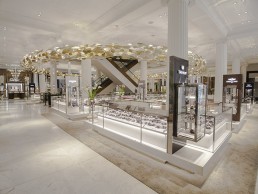
The Origin of Wonder, UK
Haberdashery has created the ‘Origin of Wonder’ sculpture for the Wonder Room at Selfridges & Co on Oxford St, London; a fantastic way to celebrate 10 years since its first installation, coincidentally at the same address back in 2007.
This latest sculpture explores the processes involved in extracting and refining the precious metals and gems found in the jewellery on display at the department store, into finely detailed objects of desire via a series of intricate graphics across more than 1,000 photo-etched brass panels. These are arranged around a 20m diameter circular formation, suspended above Europe’s most prestigious retail space.
As the sculpture flows between three distinct chapters: the ‘Origin of Wonder’, ‘Savoir-faire & Craftsmanship’ and the ‘Illuminated Article’ it showcases the organic layers and geological forces involved in the extraction of metallic elements, the highly-industrialised techniques involved in working these raw metals into incredibly detailed and beautiful forms, and finally the finished articles with their precision, detail and sense of desirability.
Installed over a five-night period during out-of-store hours, the sculpture is a perfect example of how the design studio applies a highly creative, narrative-led process through a detailed approach to management and logistics to create a stunning, original artwork in complex environments.
“It was a really difficult space to work within,” Haberdashery’s Ben Rigby tells darc. “The whole space had a finished ceiling in place and behind that ceiling there are sprinkler systems, security cameras, motion detectors and so on, we had to make this huge sculpture hang from as few points as possible, as such it looks as though it is a very light piece, floating in the space.
“The team at Selfridges had seen our work at the House of St. Barnabas and liked the delicacy and aesthetic – the sculpture used similar etched brass panels to those we ended up using in the Wonder Room. This was our only sort of direction in terms of a brief or style, so we took that idea and put it on steroids – creating a much bigger sculpture that was much more technically evolved – there’s a lot more going on in this piece.
“This is our first big public sculpture in London and what we’re most proud of is that it feels as though it’s always been there. The main feedback we’ve had is that it feels as though the room has been built around the sculpture, so we’ve managed to create something that’s truly appropriate for the space and compliments the architecture perfectly.”
Looking at the three sculpture chapters in more detail, the first chapter really focuses on the discovery of the metal elements and as such the panels are quite rough around the edges and less constrained, with the graphics exploring earthy qualities. The second chapter is much more about the ‘can-do’ attitude of the craftsmen who take the metals and work them into a toolkit for creating wonderful objects, such as jewellery. At this stage, the graphics become a bit more refined and you can see patterns that derive from sparks coming off a welding torch, alongside details of the technology used to drill into the metals the craftsmen are working on. The final chapter focuses on the finished article, with everything finely polished and refined, with the graphics highlighting the cogs inside a watch or details taken from the jewels.
“We wanted different patinas on the brass so that you can see the evolution as you walk around the piece,” says Rigby. “The three chapters take us straight from the ground right through to the finished object. We were looking for very soft, light, pastel finishes, which was a challenge in itself as no one we went to seemed to have these finishes available. We had to get the finishes just right, anything too dark would have made the sculpture feel heavy and oppressive.”
The sculpture makes use of custom-designed LED lighting to bring the piece to life. Used to illuminate the graphic panels, the LEDs stand off the main tubular frame and shine back onto the piece, throwing light back. “This really picks off the graphics,” continues Rigby. “We had to make the lighting units easily accessible for maintenance purposes and very flexible in terms of control so as to not detract attention away from the jewellery brands on show. You also get some nice reflections on the ceiling as the light bounces off / goes through the panels.
For Rigby, the sculpture brings a certain unity to the space at Selfridges and gives customers even more of a reason to walk around and explore the space. “There’s so many brands in there competing for customers’ attention that you need to bind them all together somehow and I think the circular nature of the sculpture does just that.”



